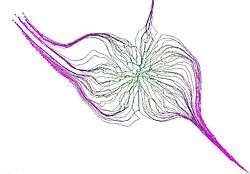Neighbour-sensing model

The neighbour-sensing model is the proposed hypothesis of the fungal morphogenesis. The hypothesis suggests that each hypha in the fungal mycelium generates a certain abstract field that (like the known physical fields) decreases when increasing the distance. The proposed mathematical models deal with both scalar and vector fields. The field and its gradient are sensed by the hyphal tips that choose the growth direction following some supposed algorithm. The model was suggested by Audrius Meškauskas and David Moore in 2004 and supported using the supercomputing facilities of University of Manchester.
The key idea of this hypothesis is that all parts in the fungal mycelium have the identical field generation systems, field sensing mechanisms and growth direction altering algorithm. Under properly chosen model parameters it is possible to observe the transformation of the initial chaotic structure into various forms, some of them similar to the fungal fruit bodies and other complex structures.
In one of the simpliest examples, it is supposed that the hyphal tips try to keep a 45 degree orientation with relation to the Earth's gravity vector field and also generate some kind of the scalar field that the growing tips try to avoid. This combination of parameters leads to development of the cone-like structures, similar to the fruit bodies of some primitive fungi.

In more complicated example, the hypha generate the vector field, parallel to the hyphal axis, and the tips have a tendency to turn parallel to that field. After more tips turn in the same direction, their hypha form a stronger directional field. In this way, it is possible to observe spontaneous orientation of the growing hypha into single direction. If we additionally suppose that the tips try to keep some optimal absolute value (magnitude) of that vector field, it is possible to observe the cord formation, known in some fungal species.
Even more various structures (including mushroom - like shapes) are obtained supposing that the growth direction strategy depends on the internal biological clock.
The Neighbour-Sensing model explains how various fungal structures may arise without supposing any kind of the growth regulating hormones. These hormones, playing important role in plant and animal development, cannot be found in fungi.
Literature
- Meškauskas A, Fricker M.D, Moore D (2004). Simulating colonial growth of fungi with the Neighbour-Sensing model of hyphal growth. Mycological research, 108, 1241-1256.
- Meškauskas, A., McNulty, Moore, D. (2004). Concerted regulation of tropisms in all hyphal tips is sufficient to generate most fungal structures. Mycological research, 108, 341-353.
- Money NP. (2004) Theoretical biology: mushrooms in cyberspace. Nature, 431(7004):32.